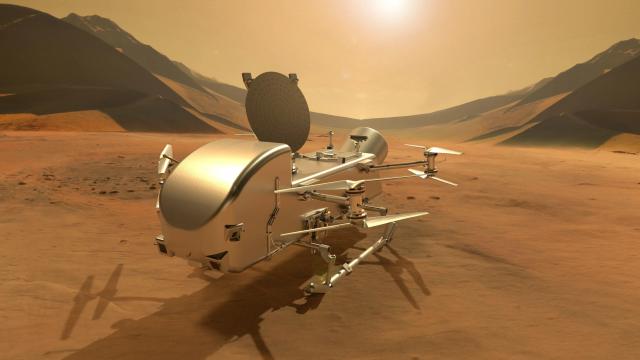A car-sized rotorcraft is getting ready to soar through the thick atmosphere of Saturn’s largest moon. Before it’s ready to explore the possible habitability of the bizarre methane-soaked world, Dragonfly was put to the test here on Earth, flying through intense wind tunnels that simulate the alien conditions on Titan.
NASA engineers carried out a series of tests at the Subsonic Tunnel at the Langley Research Center in Hampton, Virginia to ensure that Dragonfly will be able to fly through Titan’s atmosphere, according to the space agency. A half-scale Dragonfly lander model, complete with eight rotors, was tested in the 14-by-22 Subsonic Tunnel.
The recent tests focused on two flight configurations, Dragonfly’s descent and transition to powered flight once it arrives at Titan, and its forward flight over the surface of the moon. The rotorcraft completed more than 700 total runs through the wind tunnels, with 4,000 individual data points.
“We tested conditions across the expected flight envelope at a variety of wind speeds, rotor speeds, and flight angles to assess the aerodynamic performance of the vehicle,” Bernadine Juliano, test lead at the Johns Hopkins Applied Physics Laboratory (APL), said in a statement. “All test objectives were successfully accomplished and the data will help increase confidence in our simulation models on Earth before extrapolating to Titan conditions.”
Scientists didn’t know that much about Titan until the Cassini spacecraft arrived in Saturn’s orbit in July 2004. Cassini conducted more than 100 close flybys of Titan, revealing an ocean world with rivers, lakes, and seas of liquid ethane and methane. The methane can form clouds and even rain, the same way water does on Earth. Titan serves as the ideal environment to study conditions necessary habitability for a life form that would be very different from the one found on our own planet.
“The surface of Titan is one of the most Earthlike places in the solar system, albeit at vastly colder temperatures and with different chemistry,” NASA writes. “Here it is so cold (-179 degrees Celsius) that water ice plays the role of rock.”
Titan’s low gravity and dense atmosphere will make it easy for Dragonfly to soar above its surface. The spacecraft is about the size of a small car, and it has four arms that each hold two helicopter rotors stacked atop one another. Dragonfly will explore Titan in short flights, building up to a series of longer “leapfrog” flights of up to 8 kilometres and making pitstops along the way to take samples from its surrounding environment.
Dragonfly is scheduled to launch no earlier than 2027 and arrive at Titan in the mid-2030s. “With Dragonfly, we’re turning science fiction into exploration fact,” Hibbard said. “The mission is coming together piece by piece, and we’re excited for every next step toward sending this revolutionary rotorcraft across the skies and surface of Titan.”
